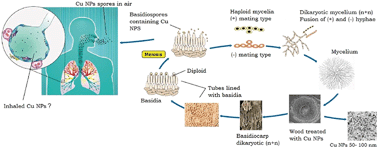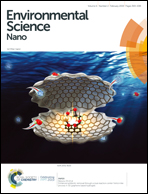Micronized copper-treated wood: copper remobilization into spores from the copper-tolerant wood-destroying fungus Rhodonia placenta
Abstract
Different brown rot wood-destroying fungi have the ability to develop Cu-tolerance mechanisms in order to effectively grow and decompose wood treated with copper (Cu), a compulsory biocide for in ground timber structures. We analyzed if the Cu-tolerant wood-destroying basidiomycete Rhodonia placenta (Empa 45) is able to compartmentalize Cu in its basidiospores. In addition, we assessed if the use of micronized copper (MC) wood preservative formulations, composed of basic Cu carbonate particles with sizes ranging from 1 nm to 250 μm, could lead to basidiospores loaded with Cu-based nanoparticles (NPs) that may be released, inhaled and cause adverse health effects, due to specific nano effects. In our study we combined elemental analysis and visual inspection to quantify the amount of Cu and its distribution in basidiospores, as well as spectroscopic techniques to investigate Cu speciation. Our results indicate that basidiospores from R. placenta (Empa 45) can accumulate Cu, however the initial Cu-based NPs undergo a change in speciation. Therefore, no specific nano-specific risk was highlighted.



 Please wait while we load your content...
Please wait while we load your content...